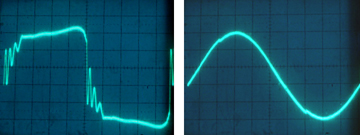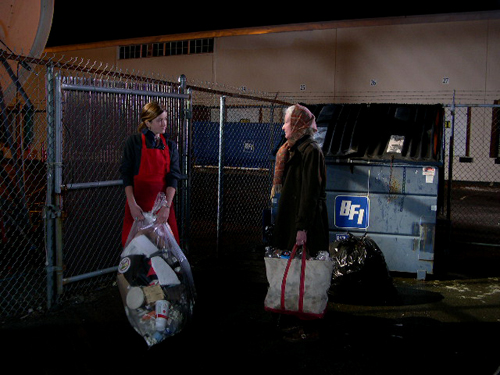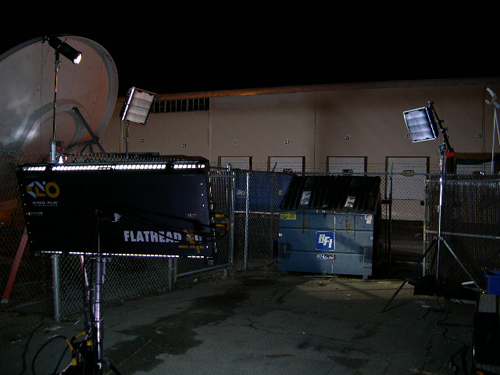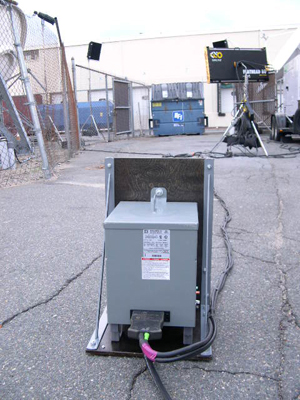http://www.pclightingsystems.com/
I have never used them but the lights look like a great deal.
Here is an example of "you get what you pay for" and highlights the difference between ballasts with Power Factor Correction and ballasts without. The ballasts of inexpensive Fluorescent Biax fixtures (like these), of the inexpensive Compact Fluorescent (CFL) fixtures, as well as those of the older style Kino Flo fixtures (that use the T-12 tubes, i.e. the Single, Double, and 4 Bank Fixtures, the Wall-o-Lite, Flathead 80, and the Image 20, 40, & 80 fixtures) are not power factor corrected and return harmonic currents into the power stream. With power factors between 0.5 and 0.7, non-power factor corrected fluorescents can be the cause of a considerable amount of harmonic distortion in a power stream. On their website Lowell warns of their compact fluorescent (CFL) fixture, the Lowel Ego: “The lamps may cause interference with radios, cordless phones, televisions, and remote controls. If interference occurs, move this product away from the device or move to a different outlet.”(
http://www.lowel.com/ego/lamp_info.html) When used in quantity, as in chroma key productions or news sets, non-PFC fluorescent ballasts can constitute a source of considerable harmonic noise in the power stream of a studio. For this reason, Kino Flo cautions users, on their website: “Kino Flo ballasts are generally not power factor corrected. They will draw double the current on the neutral from what is being drawn on the two hot legs. On large installations it may be necessary to double your neutral run so as not to exceed your cable capacity.”( FAQ “Why is the neutral drawing more than the hot leg” at
http://www.kinoflo.com/FYI/FAQs.htm#2)
The advantage to the Kino Flo Biax fixtures (the Diva, Parabeam, Vistabeam, and Barfly) is that they have Power Factor Correction circuitry built into then. As it does in HMI ballasts, this advanced electronics contributes to a more economical use of power than conventional electronic ballasts and reduces the return of harmonic currents into the power stream. With a Power Factor Rating of over .9, the Kino Flo Biax fixtures are especially well suited for use in large quantities on small portable generators and in studio applications.
Left: Grid Power w/ no load and a THD of less then 3%. Center: Conventional Generator w/ no load and a THD of 17-19%. Right: Inverter Generator w/ no load and a THD of 2.5%.
For all practical purposes, when you plug a single 4’ - 4 Bank Kino into a wall outlet you need not be concerned about harmonic currents. It is, however, an all together different situation when plugging Kino Flo T-12 fixtures into conventional portable generators. As a comparison of the oscilloscope shots above and below indicate, the return of harmonic currents by conventional Kino Flo T-12 ballasts can generate voltage distortion in the power stream. Given the large sub-transient impedance of conventional portable generators, and the fact that the original supply voltage waveform of conventional generators is appreciably distorted (a THD of 17-19%) to begin with, you have a situation where the return of any harmonic currents by a non-PFC electronic ballast (HMI or Kino) will result in significant waveform distortion of the voltage in the distribution system.
Left: Grid Power w/ Kino Flo Wall-o-Lite. Center: Conventional AVR Power w/ Kino Flo Wall-o-Lite. Right: Inverter Power w/ Kino Flo Wall-o-Lite.
Given the effect of just one 10–tube Kino Flo Wall-o-Lite with non-pfc electronic ballasts on the power of a 5500W conventional generator that we see in these oscilloscope shots, I wondered what would be the accumulative effect of a typical lighting load on a generator? To see, I ran a package consisting of two Arri 1200 HMI Par Pluses with standard Arri non-PFC electronic ballasts in addition to the Kino Flo Wall-o-Lite on the Honda EX5500 (a conventional generator). And, for the sake of comparison, I ran the same package but with power factor corrected electronic ballasts on a modified EU6500is (an inverter generator.) The resulting waveforms are the two included in my previous post - the difference between them is startling. As I state in my previous post, the adverse effects of the severe harmonic noise exhibited, can take the form of overheating and failing equipment, efficiency losses, circuit breaker trips, excessive current on the neutral return, and instability of the generator’s voltage and frequency. For these reasons it has never been possible to reliably operate more than a couple of 1200W HMIs on a conventional 6500W portable gas generator. Harmonic noise of this magnitude can also damage HD digital cinema production equipment, create ground loops, and possibly create radio frequency (RF) interference.
Why are harmonics suddenly an issue in motion picture electrical distribution systems? First, one must appreciate that the power generation and electrical distribution systems developed for motion picture production were never designed to deal with an abundance of non-linear loads like electronic HMI and Kino Flo ballasts. It’s a problem that has only recently begun because of the increasing use of these types of non-linear lighting loads. The problem is being further compounded by the increasing prevalence on set of sophisticated electronic production equipment like computers, hard drives and HD monitors which are themselves sources of harmonic distortion. The increasing use of these microprocessor-based equipment in production has created an unprecedented demand for clean, reliable power on set at a time when the prevailing light sources are dumping more and more noise into the power stream.
It is worth noting in the oscilloscope shots above that the distortion of the voltage waveform is considerably less in the case of the inverter Honda EU6500is generator (far right) than that of the conventional Honda EX5500 generator (left.) The reason for this is that, the original waveform of the power generated by the EU6500is (an inverter generator) has less harmonic distortion at the outset than that originally generated by a EX5500 (conventional generator.) For this reason, when your lighting package consists predominantly of non-linear light sources, like HMI and Fluorescent lights, it is important to have power factor correction (PFC) circuitry in the ballasts (HMI & Kino) and operate them on inverter generators like a modified Honda EU6500is. The combination of improved power factor and the nearly pure power waveform of inverter generators makes it possible to power larger lights, or more smaller lights, than has been possible before on a small portable gas generator.
For example, the substantial reduction in line noise that results from using power factor corrected Kino and HMI ballasts on the nearly pure power waveform of an inverter generator creates a new math when it comes to calculating the load you can put on a generator. In the past we had to de-rate portable gas generators because of the inherent short comings of conventional generators with AVR and Frequency governing systems when dealing with the harmonic noise of non-PFC electronic ballasts. The harmonic distortion created by non-PFC ballasts reacting poorly with the distorted power waveform of conventional AVR generators (as evident in the oscilloscope shots above) limited the number HMIs and Kinos you could power on a portable generator to 60% of their rated capacity (4200Watts on a 6500W Generator).
Wide Shot of Night exterior scene lit with a pkg. consisting of PFC 2.5 & 1.2 HMI Pars, PFC 800w Joker HMI, Kino Flo Flat Head 80, 2 ParaBeam 400s, and a ParaBeam 200 .
But now, that inverter generators have virtually no inherent harmonic distortion or sub-transient impedance and power factor correction (PFC) is available in both small HMI and Kino Flo Biax ballasts, this conventional wisdom regarding portable gas generators no longer holds true. Where before you could not operate more than a couple 1200W HMIs with non-PFC ballasts on a conventional generator because of the consequent harmonic distortion, now according to the new math of low line noise, you can load an inverter generator to capacity. And if the generator is a modified EU6500is inverter generator, you will be able to run a continuous load of up to 7500W as long as your HMI and Kino ballasts are Power Factor Corrected.
PFC 2.5 & 1.2 HMI Pars, PFC 800w Joker HMI, Kino Flo Flat Head 80, 2 ParaBeam 400s, and a ParaBeam 200 powered by a modified Honda EU6500is through a 60A Full Power Transformer/Distro
According to this new math, when you add up the incremental savings in power to be gained by using only PFC ballasts, and combine it with the pure waveform of inverter generators, you can run more lights on a portable gas generator than has been possible before. For example, the 7500W capacity of a modified Honda EU6500is Inverter Generator powered a lighting package for a recent Red shoot (see production stills above and below) that consisted of a PFC 2.5kw HMI Par, PFC 1200, & 800 HMI Pars, a couple of Kino Flo ParaBeam 400s, a couple of ParaBeam 200s, and a Flat Head 80. Given the light sensitivity of the Red camera, this was all the light needed to light even a large night exterior.
A Distro System consisting of a 60A Full Power Transformer/Distro, 2-60A GPC (Bates) Splitters, 2-60A Woodhead Box distributes power from a modified Honda EU6500is. Even though the generator is 100' away to reduce noise, plug-in points remain conveniently close to set.
Given the light output of the Kino Flo Biax Fixtures (especially the Parabeams), how well their ballasts interact with inverter generators, their versatility (they can operate both 5500K & 3200K lamps) and their efficiency (they consume 1/10 the power of comparable incandescent soft lights), the Kino Flo Biax Fixtures would appear to be a better fluorescent light source for the production of narrative HD Cinema.
Guy Holt, Gaffer, ScreenLight & Grip, Boston







